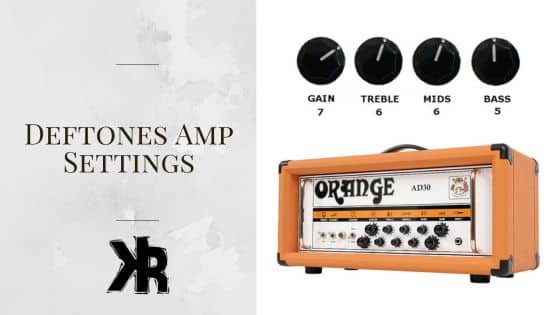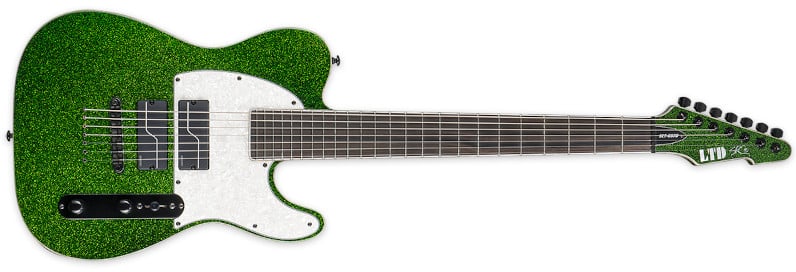Table of Contents
Deftones, the renowned alternative metal band, have charmed audiences around the world. Their unique sound and powerful performances owe much to their guitar tone. But in order to recapture their sound for yourself, you need meticulously crafted amp settings.
What makes the Deftones amp settings stand out is the combination of technical expertise and artistic vision. Stephen Carpenter experiments with effects pedals and amp models to discover new sonic territories.
However, if you just need quick amp settings, these will get you started:
- Gain: 7
- Treble: 6
- Bass: 6
- Mids: 5
Their sound has evolved throughout their career. From aggressive tones in early years to more nuanced sounds in later albums. In this Killer Rig article, we are going to explore their journey and help you recreate their tone with your gear.
What is the Deftones Sound?
Deftones are known well for their unique sound. They combine aggressive rock with tranquil beauty, and their music features heavy riffs, melodic vocals, and shifts in texture and intensity.
The band’s debut album “Adrenaline” and their release of “Ohms” showcase their boundary-pushing alternative metal. Their sound is crafted with meticulous care in songwriting and production.
Deftones contrast dynamics, transitioning fluidly from soft passages to crushingly heavy sections. This dynamic between light and dark is their signature.
Their guitar work is also noteworthy! Stephen Carpenter’s downtuned riffs form a heavy foundation, and feature inventive chord progressions and atmospheric effects.
Their lyrics explore introspective themes such as love, loss, and existentialism. Chino Moreno’s emotive vocals add yet another layer of depth to the music.
At one concert, a fan was moved by the emotional energy of “Change (In the House of Flies),” creating a powerful connection between artist and audience. Deftones are an undeniable force in rock music.
Understanding Deftones Amp Settings
Amplifier settings are crucial for achieving the desired tone. Here is a concise breakdown of understanding how they work:
- Gain: The gain control adjusts the amplifier’s input sensitivity. Higher gain settings produce a distorted sound, while lower ones result in a cleaner tone.
- EQ Controls: The equalization controls consist of bass, mid, and treble knobs. These allow you to shape the tone by boosting or cutting different frequency ranges.
- Presence Control: The presence control affects the overall brightness of the sound. Increasing it adds clarity and definition, while decreasing it makes the tone warmer.
- Reverb: The reverb knob adjusts the amount of reverberation or spaciousness in the sound.
Additionally, it’s essential to pay attention to unique details such as the specific amplifier model, guitar pickups, and playing style when dialing in your gear. These factors strongly influence the final sound produced, so experimentation is encouraged.
Not sure what amp settings actually do? Check out my guide to amp controls and settings to get up to speed!
Fine-tuning
Achieving the perfect tone on your amplifier involves making precise adjustments to your settings. Every amp responds differently, so this isn’t a one size fits all procedure. Follow these 5 steps to fine-tune your amp:
- Start with the basics: Set your volume and gain to a comfortable level, then adjust the bass, mids, and treble knobs to neutral positions.
- Experiment with EQ: Gradually modify the EQ knobs to enhance the desired frequencies. Try boosting the mids for a fuller sound or tweaking the treble for more crispness.
- Analyze the tone controls: Pay attention to any additional tone controls on your amp, such as presence or resonance knobs. These can significantly impact the overall tone and help you tailor it to your liking.
- Utilize effects and pedals: If you use effects pedals, try out different combinations and adjust the amp settings accordingly. This way, you can achieve the desired tone while also maintaining clarity.
- Pay attention to the environment: Consider the room where you will be playing. Adjust your amp settings accordingly to compensate for any acoustical properties that might affect the sound quality.
To further enhance your sound, it’s essential to consider unique details that often go unnoticed. Take note of how different amps respond to your playing style and guitar type.
Experiment with alternative speaker cabinets, or try different types of tubes to achieve varying results. These subtle changes can make a significant difference in your sound quality.
Get your Foo Fighters amp settings here!
Popular Deftones Songs and Their Amp Settings
Deftones’ music is a rich tapestry of sound, and each song has its own unique flavor. Let’s dive into some of their most popular tracks and explore the amp settings that help create their iconic sound.
Change (In the House of Flies)
- Gain: 7
- Bass: 5
- Mid: 5
- Treble: 6
- Presence: 4
- Reverb: 2
This song’s haunting melody and heavy riffing are achieved through a balanced EQ and moderate gain. The reverb adds an ethereal quality, reflecting the song’s introspective lyrics. Use your guitar volume control for the less distorted parts.
Get your Linkin Park amp settings here!
My Own Summer
- Gain: 7
- Bass: 6
- Mid: 4
- Treble: 6
- Presence: 5
- Reverb: 2
A punchy and aggressive tone is the hallmark of this track. The gain is cranked up, and the mids are scooped out, giving it a raw edge. The bass adds depth, while the treble provides clarity.
Check out these Bullet For My Valentine amp settings!
Diamond Eyes
- Gain: 6
- Bass: 6
- Mid: 5
- Treble: 7
- Presence: 6
- Reverb: 2
This song’s shimmering quality is achieved through a balanced EQ and a touch of reverb. The gain is set to a moderate level, allowing the guitar’s natural tone to shine through.
Be Quiet and Drive
- Gain: 7
- Bass: 6
- Mid: 5
- Treble: 6
- Presence: 5
- Reverb: 3
The driving force of this song is captured with a well-rounded EQ. The gain adds grit, while the presence control adds definition to the chords. A low setting of reverb to fill it out.
Digital Bath
- Gain: 5
- Bass: 6
- Mid: 6
- Treble: 5
- Presence: 4
- Reverb: 4
The dreamy and atmospheric quality of this song is achieved through a balanced EQ and a higher reverb setting. The gain is set lower to allow the subtleties of the guitar work to come through.
Tips and Tricks
Achieving the Deftones sound involves more than just dialing in the right amp settings. It’s a blend of understanding your gear, playing with effects, and paying attention to guitar techniques. Here’s a detailed guide to help you capture their unique tone:
Understand Your Gear
Not every piece of gear is the same. Spend time getting to know your guitar, amp, and pedals. Understand how they respond to different settings and how they interact with each other. This knowledge will help you fine-tune your sound and get closer to the Deftones’ tone.
Experiment with Effects
Deftones make extensive use of effects in their music. Don’t be afraid to try out different pedals and effects to see how they can shape your sound.
Distortion, chorus, delay, and reverb are all good starting points. Exploration can lead to discovering new sonic territories, just like Stephen Carpenter.
Pay Attention to Playing Technique
The way you play your guitar can have a significant impact on your tone. Pay attention to how the members of Deftones play their instruments.
Notice their picking technique, how they use palm muting, and any other unique techniques they employ. Emulating these techniques can help you get closer to their sound.
Use an Effects Loop (If Available)
If your amplifier has an effects loop, consider using it. Placing certain effects after the preamp stage of your amplifier can result in a cleaner, more defined tone.
This technique will enhance the overall quality of your tone, especially when using effects like delay or reverb. Otherwise, if you run them through a distorted channel, they will sound bad.
Conclusion
The Deftones amp settings can help musicians craft their desired sound. They can unlock new sonic possibilities by looking into the intricacies of this setup. The band’s approach to their signature tone plays a big role in their success.
It’s important to experiment and personalize. Every guitarist has their own style. With gain, EQ, and reverb, they can create a sound that reflects their individuality. The Deftones are an inspiration for this.
Guitarists should use unconventional techniques too, like effects pedals. Delay, chorus, and wah pedals can push boundaries.
Frequently Asked Questions
What amps does Stephen Carpenter use?
Stephen Carpenter of Deftones primarily uses a Marshall JMP-1 Tube MIDI Guitar Preamp along with a Marshall 9200 MonoBlock Power Amp. This combination contributes to his distinctive sound and has been a key part of his setup.
What guitar pedals does Deftones use with their amp?
Deftones has used various guitar pedals throughout their career to shape their sound. Some notable pedals include the Boss FZ-2 Hyper Fuzz, Boss BF-3 Flanger, MXR Carbon Copy, Eventide H9, and Digitech Whammy.
Can I achieve Deftones’ tone with a different amplifier?
Yes, you can still achieve a similar tone to Deftones with a different amplifier. Look for an amp with high gain capabilities and the ability to shape the tone through EQ controls. Play around with different settings and pedals to find the right combination that suits your gear and style.
Are there any specific amp settings for Deftones’ clean tones?
While Deftones are known for their heavy sound, they also incorporate clean tones in their music. For clean tones, reduce the gain significantly and adjust the EQ settings to produce a cleaner and brighter sound. Use pedals like chorus or delay to add depth and texture to the cleans.


